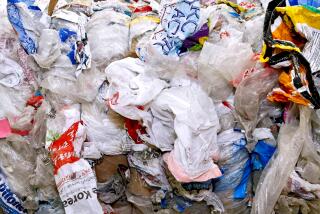Expanded recycling law may tap consumers’ pockets
SACRAMENTO — Californians could soon be paying new deposits on half-gallon juice jugs, small juice boxes and soy drink containers -- and handing over twice as much as they already pay on some soda and water bottles -- because lawmakers have been raiding the state’s recycling fund to help balance the budget.
Officeholders have yet to repay $451 million they’ve taken from the recycling fund since 2002 to cover the state’s bills, siphoning away $100 million this year alone. Recycling and deposit redemptions, meanwhile, have risen amid the recession and the fund is now facing bankruptcy.
The Legislature recently passed a vast expansion of California’s recycling program. The proposal would replenish the fund by imposing new 5-cent deposits or doubling existing ones on billions of containers. Buyers could get the deposits back, as usual, by turning in the empty containers.
If Gov. Arnold Schwarzenegger signs the measure into law, consumers will pay an estimated $295 million more per year on beverage containers, according to the state Department of Conservation. The governor has not taken a public position on the measure, which would create no new environmental programs.
Opponents call the Legislature’s proposal a hidden tax, the product of years of botched fiscal management.
“It’s a backdoor tax increase,” said Sen. George Runner (R-Lancaster).
Recycling advocates concede that the larger deposits won’t pay for new programs. But they say extending deposits to more than 5 billion containers annually will curb the waste that ends up in landfills.
“This crisis created an opportunity to expand and improve the recycling program,” said Mark Murray, executive director of Californians Against Waste, a nonprofit recycling group.
The current threshold for 10-cent deposits is 24 ounces. The new legislation would lower that, capturing an extra nickel on the ubiquitous 20-ounce bottles, of which there are an estimated 3.6 billion in circulation annually in California.
Among the containers that would be newly subject to deposits are juice jugs larger than 46 ounces; half-gallon cartons (milk excluded); small foil pouches, such as those used in Capri-Sun; 8-ounce juice boxes; and containers of drinks made from almond, soy, rice and other grains -- all currently exempt.
The new structure would go into effect July 1, 2010.
“Maybe it will make people more aware of our container usage,” Eve Imagine, a 37-year-old city college professor in Sacramento, said as she unloaded a Prius full of bottles and cans at a recycling center. “It’s a tax -- I see that. I will just continue to recycle.”
Fellow capital resident Kathy Lockhart, 51, who is unemployed, disagreed: “I don’t want to give them any more money.”
Created in 1986, California’s recycling program requires a deposit on beer, water, soda and other drinks in aluminum, plastic and glass containers. Consumers pay 5 cents for small containers, 10 cents for large ones. A byzantine set of rules governs which containers and drinks are affected.
Unredeemed deposits go into the state’s recycling treasury, which spreads the money to environmental programs, local governments and industry subsidies.
The recycling rate reached 74% in 2008, up from 67% the year before. Without repayment of the $451 million the state took, the fund was broke this summer. Except for people recycling bottles and cans, officials cut disbursements from the fund by 85% on July 1.
The Schwarzenegger administration did not expect the fund to dive into the red when it proposed borrowing $100 million from it in early in 2009, said finance department spokesman H.D. Palmer. Lawmakers rejected the administration’s plan to balance the fund and, in the final hours before the year’s lawmaking deadline, approved the higher deposits.
The bill, SB 402 by Sen. Lois Wolk (D-Davis) received only a single hearing -- on the final day of the session.
Assemblywoman Nancy Skinner (D-Berkeley), who shepherded the legislation, said it is necessary “to make the program whole and make sure that recycling continues.”
The soda industry, which produces many of the containers facing new or higher deposits, was more skeptical.
“The money’s been taken for other purposes,” said Bob Achermann, executive director of the California/Nevada Soft Drink Assn. “It seems a bit disingenuous.”
If the governor doesn’t sign the legislation, environmental advocates say, the effects will ripple across California.
State-subsidized recycling depots, such as those in supermarket parking lots, could close. Manufacturers’ processing costs would rise if state money continues to shrink. Local conservation corps, which employ and train at-risk youths with money from the fund, could be imperiled.
Scott Dosick, a spokesman for the California Assn. of Local Conservation Corps, estimated more than 1,000 youths could be removed from programs statewide. The corps’ state subsidy could be cut by $16 million. “Not only were we using the funds to recycle over 15 million bottles and cans [in 2008], we were using them to transform lives,” he said.
Powerful industries, some of whose recycling costs have long been subsidized by California’s deposit fund, are lobbying for the bill.
“The impact to our company was $7 million,” said Julian Green, spokesman for MillerCoors, the country’s second-largest beer company, referring to the July 1 cutback.
Skinner said producers’ extra costs will ultimately be borne by consumers, who would pay more for their products. The higher deposits at the cash register, in contrast, could be redeemed.
The prospect of higher redemptions excited at least one person recently.
“More money, better for us,” said Taz, a 50-year-old homeless man in Sacramento who makes his living collecting recyclables. “They should definitely raise it.”
--
More to Read
Get the L.A. Times Politics newsletter
Deeply reported insights into legislation, politics and policy from Sacramento, Washington and beyond. In your inbox three times per week.
You may occasionally receive promotional content from the Los Angeles Times.










